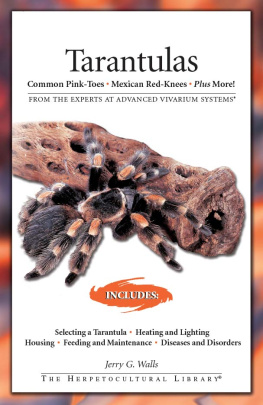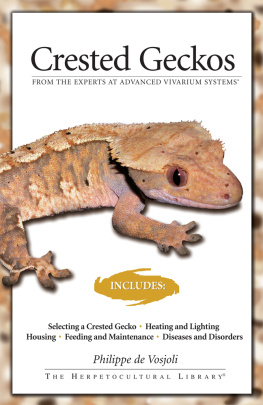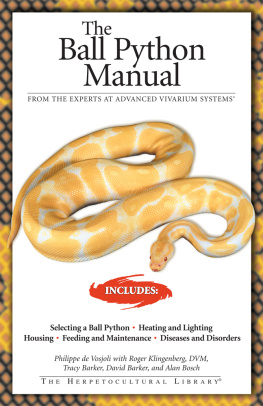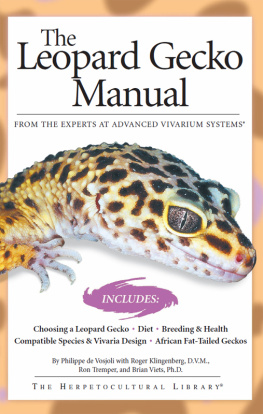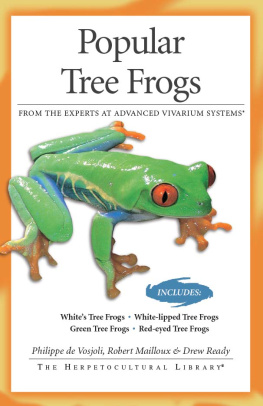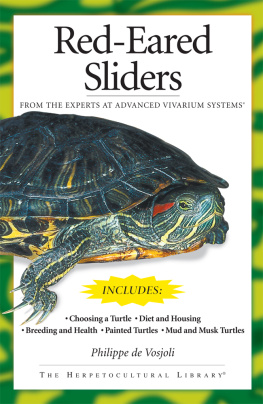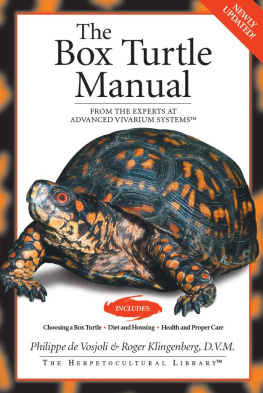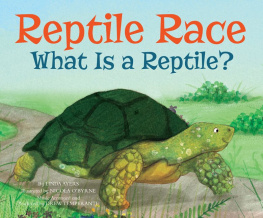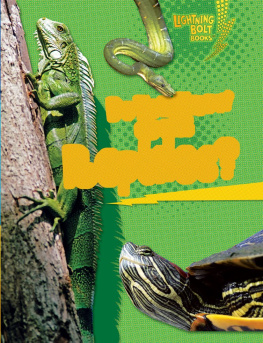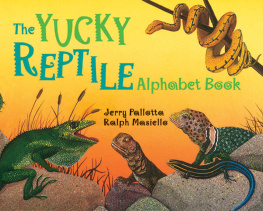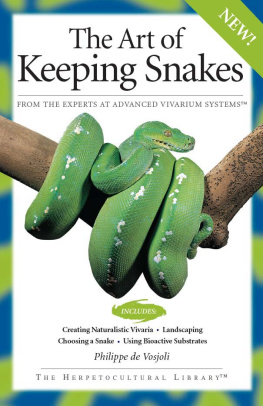Karla Austin, Business Operations Manager
Nick Clemente, Special Consultant
Barbara Kimmel, Managing Editor
Jessica Knott, Production Supervisor
Honey Winters, Designer
Design concept by Michael Vincent Capozzi
Indexed by Melody Englund
Photographs by Paul Freed.
Copyright 2007 by Advanced Vivarium Systems
All rights reserved. No part of this book may be reproduced, stored in a retrieval system, or transmitted in any form or by any means, electronic, mechanical, photocopying, recording, or otherwise, without the prior written permission of Advanced Vivarium Systems, except for the inclusion of brief quotations in an acknowledged review.
LCCN: 96-183295
ISBN: 1-882770-92-7
eISBN: 9781620080481

An Imprint of I-5 Press
A Division of I-5 Publishing, LLC
3 Burroughs
Irvine, CA 92618
Printed and bound in Singapore
10 9 8 7 6 5 4 3 2 1
CONTENTS
INTRODUCTION
K eeping reptiles and amphibians in glass boxesvivaria or terrariais a hobby that has been popular for almost two centuries in Europe and the United States. Early German and British hobbyists developed the basics of how we keep reptiles and amphibians today. Some say that the hobby reached its peak with the work of the German naturalist Willy Wolterstorff (18641943), who succeeded in keeping and breeding delicate newts and other salamanders that even today are considered tough or nearly impossible to keep.
However, the modern vivarium hobby is changing rapidly, with new materials and new methods becoming available at a stunning pace. In my opinion, there has never been a better time to keep a vivarium. Now even a beginner can succeed without years of experience.
In this book, Ill talk about the many types of containers and substrates available and discuss ways of lighting and heating a vivarium that our predecessors could only dream of just a few decades ago. After you read this book, you will be able to find your way through the equipment section of a pet shop and recognize the equipment that best fits your needs. You also will develop an idea of which equipment is really necessary and which is a luxury.
Although this is not a book about vivarium animals, there should be enough examples mentioned of commonly kept amphibians and reptiles for you to handle most species found in pet shops. Ive included an introduction to outdoor cages for turtles and tortoises or chameleons and large lizards.
For the material in this book, Im indebted to the works of such modern vivarium masters as Philippe de Vosjoli, R. D. Bartlett, and Rex Lee Searcey as well as earlier workers such as Willy Wolterstorff and Elke Zimmermann.
CHAPTER 1
THE CAGE REALLY MATTERS
T he proper way to set up a vivariumthe cage in which your nonaquatic reptile or amphibian pet will spend its lifehas long been a controversial but essential topic in the herpetocultural hobby. There is no single correct way to keep any reptile or amphibian (called herps for short). There are many ways that work and some that dont. Each way has its advantages and problems, its advocates and detractors. The goal of this book is to give you an idea of the numerous ways you can set up a vivarium and the commonly available products you can use. The book covers cages, heating and lighting, substrates (bedding), and some of the equipment you will find useful.
There are too many species of herps from too many different habitats to give exact plans for building vivaria for every particular type of herp. Instead, this book will provide good, general ideas on how to make a habitat for your pet, focusing on a few basic types of environments and a few common herps. For specific instructions on creating a suitable environment for your herp, consult a book about that species.
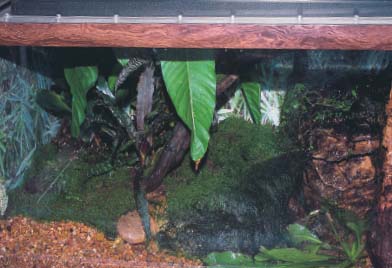
Vivaria can range from elaborate naturalistic setups, such as this one, to basic sterile setups.
Definitions
Herpetology: the study of reptiles and amphibians as a science
Herpetoculture: the care or breeding of reptiles and amphibians
Herp: shorthand slang for any reptile or amphibian
A gentle reminder: herps do not do well in cardboard boxes or plastic bags. Before buying your pet, set up its cage correctly, with the right lighting and heating to meet its needs. Know that you can buy essential foods locally and reliably. If you dont have a local source for food, start breeding your own food before purchasing a pet. Many of the common food animals, such as crickets, mealworms, superworms, and even mice, can be cultured at home at little cost. Starter cultures of many of these are available from advertisers in Reptiles magazine and over the Internet. More herps are probably lost in the first month of ownership than at any other time. A new owner may be enthused about the animal but negligent of its environment. Get the cage completed and food ready before you buy that pet lizard or snake.
Types of Cages
There are several types of cages, including aquariums, tubs, and snake drawer units. The type of cage you select will depend on your specific pets and interests. It also will depend to some extent on your budget and how deeply you plan to go into keeping your animals. If you plan to keep just one or two pets, then you probably will be willing to spend more money and time on a decorative vivarium that shows off your pets. If breeding is your major plan, then you will look more closely at cages that allow you to keep many animals efficiently in minimal space.
Vivarium vs. Terrarium vs. Aquarium
What is the difference between a vivarium and a terrarium? A terrarium is an enclosure used to raise plants and sometimes small animals. A vivarium is an enclosure used to house small animals (although it may contain plants). In herpetoculture, the term vivarium is the one most commonly used. An aquarium is an enclosure with water used to house aquatic plants and small animals.
Types of Vivaria
There are five basic types of simple vivaria for use with amphibians and reptiles. These types include:
Sterile: used for temporary housing, hospital cages, or quarantine confinement. Often used in laboratories as well.
Wet: used for many amphibians and quite a few small lizards and some turtles. A wet vivarium is used for any animal that needs lots of humidity at all times and moist bedding. The wet vivarium merges into the aquarium, especially if there is more water than there is land.
Rain Forest: a high-humidity, warm vivarium usually set up for arboreal (tree-dwelling) lizards and snakes as well as for specialized tropical tree frogs. A rain forest vivarium is usually taller than it is wide to accommodate branches.
Woodland: the basic, middle-of-the-line vivarium useful for almost all common snakes and lizards as well as some turtles.
Desert: used for lizards and desert snakes that require very dry, hot conditions.
The Aquarium
An aquarium is basically a glass-sided box meant to hold water and, usually, fish. However, it long has been the most available cage for a great variety of herps, and it still has many advantages. An aquarium is easy to purchase almost anywhere and usually is quite affordable. Today, you can even find aquariums specially designed for herps that live on mossy substrates. These aquariums have thinner glass than those designed for fish. They may even be marked Not designed to hold water. Aquariums are usually all glass, with four sides, a bottom, and a lid. The bottom is made of strong glass bonded with silicone cement for a long life and easy maintenance.
Next page

